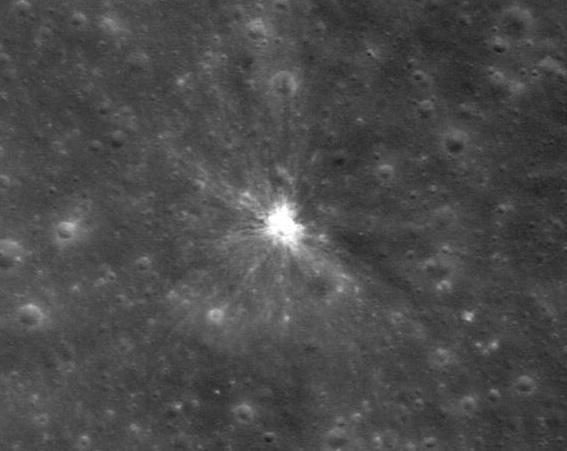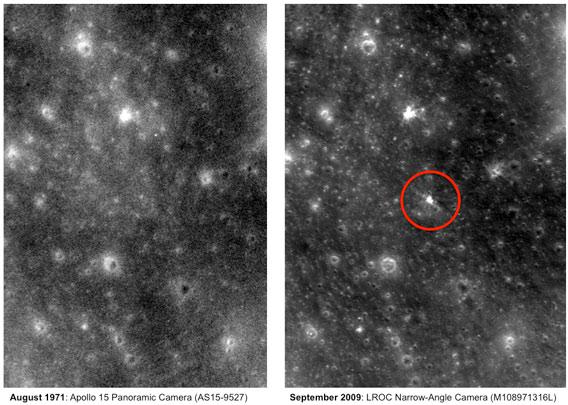When you look at the Moon, it seems frozen in time, locked in place, unchanging.
Now sure, a few days ago I posted a cool picture showing lunar boulders that, for reasons unknown, rolled downhill on the Moon. But we don’t know when that event occurred. It could have been literally tens of millions of years ago.
But, it turns out, if you keep a watchful eye on the Moon, things do change. And we have proof! Behold! The Moon’s youngest known natural crater:

Image credit: NASA/GSFC/Arizona State University
This image, from NASA’s Lunar Reconnaissance Orbiter (LRO), shows what looks like a patch of unremarkable lunar real estate. But that crater in the middle, dominating the view, is actually quite remarkable: It’s no more than 41 years old.
How do we know? Because we’ve been looking at the Moon up-close for a while. The Apollo missions put humans in orbit around the Moon, humans with cameras. During Apollo 15, which went to the Moon in 1971, command module pilot Al Worden remained in orbit and took mapping pictures of the surface. He happened to get a snapshot of this area, and the crater was not in that picture:

Image credit: NASA/GSFC/Arizona State University
LRO took the shot on the right in 2009, so the crater was formed sometime before then, but no earlier than 1971. Note too that above, I said this was the youngest natural crater. That’s because in the later Apollo missions, the spent third stage of the Saturn V rocket that took astronauts to the Moon was purposely sent on a trajectory to impact the Moon. Seismometers left by earlier missions could then be used to measure the energy of the impact and learn more about the Moon’s interior, just as earthquakes here on Earth can be used by scientists to learn more about our planet’s interior. Five new craters are on the Moon from those impacts (from Apollo missions 13 to 17), but no hardware was sent to hit near the crater pictured above, leaving only natural causes to explain it.
This new crater is about 10 meters (roughly 30 feet) across. Given typical impact velocities, whatever hit the Moon—most likely a small asteroid—must have been about 50 centimeters (20 inches) or so across. Slamming into the Moon at dozens of times the speed of a rifle bullet, the energy of its impact carved out that crater. Incredible!
Perhaps even more incredible is the fact that anyone found this crater at all. Can you? The original overview image from LRO is online, where you can pan and scan over it. It took me a few minutes to find this crater, and I knew it was there. Imagine having to go through all the images like this and compare them to earlier ones from Apollo, not even knowing what you might find! That’s a serious amount of work.
But it paid off. There’s science to be learned here: Fresh impacts overturn the surface of the Moon, revealing what lies beneath. The rough powdery material coating the surface, called regolith, gets darker over time from solar radiation, so having very fresh regolith can help gauge the age of other, older craters.
Does looking at maps of lunar craters sound like fun to you? It’s actually is, and I should know: I’ve done it. Moon Mappers is a “citizen science” project, where anyone can help the progress of science by participating. (Full disclosure: I’m an advisor for CosmoQuest, which is the host of Moon Mappers and other citizen science projects.) With just a few minutes of practice, you can be looking at actual LRO images and helping scientists count craters and measure their size. It really is fun, and it’s also real science. Give it a shot! You might find something cool of your own.
Tip o’ the lens cap to Emily Lakdawalla at The Planetary Society Blog.